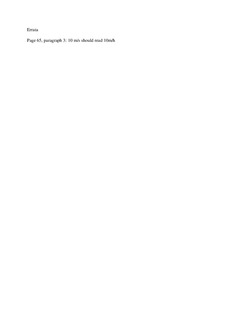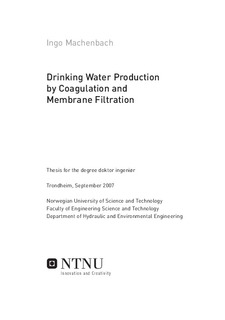| dc.contributor.author | Machenbach, Ingo | nb_NO |
| dc.date.accessioned | 2014-12-19T12:31:08Z | |
| dc.date.available | 2014-12-19T12:31:08Z | |
| dc.date.created | 2008-04-28 | nb_NO |
| dc.date.issued | 2007 | nb_NO |
| dc.identifier | 124226 | nb_NO |
| dc.identifier.isbn | 978-82-471-3845-8 | nb_NO |
| dc.identifier.uri | http://hdl.handle.net/11250/242076 | |
| dc.description.abstract | Drinking water production with low-pressure hollow-fibre membranes is becoming increasingly more widespread as replacement for conventional separation technology. Upstream coagulation can mitigate fouling layer formation on membranes and allows removal of colloidal and soluble compounds smaller than the membrane pores. However, integrating membrane systems with coagulation bears the risk of impaired system performance due to unfavourable aggregate characteristics. This is of particular importance when treating humic substances due to their strong dependence on the solution environment.
The experimental work in this study aimed at finding optimal coagulation, flocculation, and membrane operating conditions for treating a typically Nordic surface water with high humic content. Commercial aluminium-based coagulants and chitosan were applied in the pre-treatment step. Short, controlled flocculation was achieved by using a pipe, jet-mix, or packed-bed flocculator. An outside-in operated ultrafiltration system based on a polymeric hollow-fibre was used as separation unit.
The study showed that optimized coagulation conditions are crucial to successful operation of the membrane unit. For the applied raw water (colour 50 mg Pt/L), a specific aluminium dosage of 3 mg Al/L and a coagulation pH in the range of 6–6.5 were found optimal with respect to permeate quality, membrane operation, and metal residuals. Coagulant dosages exceeding the optimal dosage and a pH drop increased hydraulically not-reversible fouling significantly. Chitosan neither met the expectations for NOM removal for the investigated raw water nor did its use seem favourable in combination with a polymeric membrane. Controlling floc aggregation can reduce pressure increase rates on the hollowfibre membrane provided that flocculators are designed for low velocity gradients (G<30 s−1). The packed-bed flocculator outperformed the other flocculators. However, flocculation times longer than 5 minutes should be applied to avoid rapid backwash pressure increases on the membrane.
The membrane system was operated with fluxes in the range of 45–75 LMH during filtration and a 1.5 times higher value during backwashes. Forward filtration without air scouring proved feasible. To improve detachment of fouling layers, vigorous air scouring was used during backwashes. A filtration cycle of 30–60 minutes followed by a backwash interval of about 30 seconds gave good results. Increasing coagulant dosage and flux were the two most significant contributors to hydraulically non-reversible fouling. Water recovery only had a minor effect on the pressure development of the membrane. However, the results suggest that efficient sludge removal from the immersion tank is of importance. Operation at lower NOM concentrations left pressure increase rates unchanged, rendering the application potential of the system highest for NOM-rich surface waters. | nb_NO |
| dc.language | eng | nb_NO |
| dc.publisher | Fakultet for ingeniørvitenskap og teknologi | nb_NO |
| dc.relation.ispartofseries | Doktoravhandlinger ved NTNU, 1503-8181; 2007:175 | nb_NO |
| dc.title | Drinking Water Production by Coagulation and Membrane Filtration | nb_NO |
| dc.type | Doctoral thesis | nb_NO |
| dc.contributor.department | Norges teknisk-naturvitenskapelige universitet, Fakultet for ingeniørvitenskap og teknologi, Institutt for vann- og miljøteknikk | nb_NO |
| dc.description.degree | dr.ing. | nb_NO |
| dc.description.degree | dr.ing. | en_GB |

